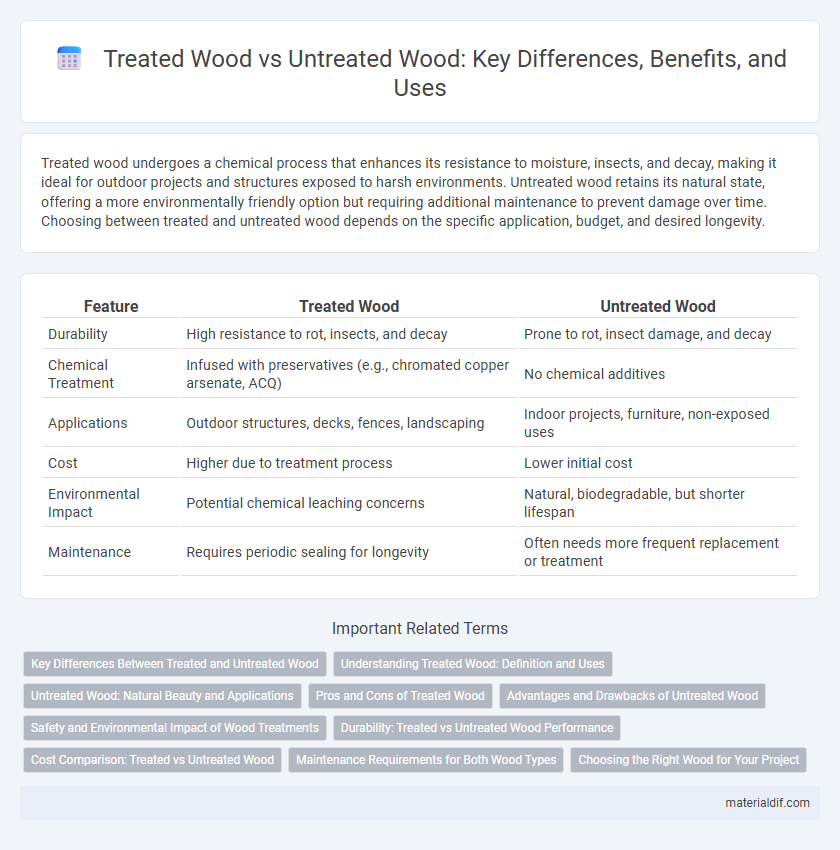Treated wood undergoes a chemical process that enhances its resistance to moisture, insects, and decay, making it ideal for outdoor projects and structures exposed to harsh environments. Untreated wood retains its natural state, offering a more environmentally friendly option but requiring additional maintenance to prevent damage over time. Choosing between treated and untreated wood depends on the specific application, budget, and desired longevity.
Table of Comparison
| Feature | Treated Wood | Untreated Wood |
|---|---|---|
| Durability | High resistance to rot, insects, and decay | Prone to rot, insect damage, and decay |
| Chemical Treatment | Infused with preservatives (e.g., chromated copper arsenate, ACQ) | No chemical additives |
| Applications | Outdoor structures, decks, fences, landscaping | Indoor projects, furniture, non-exposed uses |
| Cost | Higher due to treatment process | Lower initial cost |
| Environmental Impact | Potential chemical leaching concerns | Natural, biodegradable, but shorter lifespan |
| Maintenance | Requires periodic sealing for longevity | Often needs more frequent replacement or treatment |
Key Differences Between Treated and Untreated Wood
Treated wood is infused with chemical preservatives to enhance durability, resist rot, insects, and moisture, making it ideal for outdoor or structural use. Untreated wood lacks these preservatives, making it more susceptible to decay, insect infestation, and weather damage, thus better suited for indoor applications or where chemical exposure is undesirable. The key differences lie in their longevity, resistance to environmental factors, and suitability for specific construction purposes.
Understanding Treated Wood: Definition and Uses
Treated wood refers to lumber infused with chemical preservatives to enhance resistance against decay, insects, and moisture, making it ideal for outdoor applications like decking, fencing, and utility poles. The treatment process typically involves pressure-treating softwoods such as pine and fir, extending the wood's lifespan and structural integrity in harsh environments. Unlike untreated wood, which is more susceptible to environmental damage, treated wood ensures durability and safety in construction and landscaping projects.
Untreated Wood: Natural Beauty and Applications
Untreated wood showcases its natural beauty through unique grain patterns, rich textures, and authentic color variations that enhance aesthetic appeal in furniture and interior design. Its versatility allows use in projects where chemical resistance is not critical, such as indoor cabinetry, decorative elements, and handicrafts. The sustainability and environmental friendliness of untreated wood make it ideal for eco-conscious applications requiring minimal processing.
Pros and Cons of Treated Wood
Treated wood offers enhanced durability and resistance to decay, insects, and moisture, making it ideal for outdoor projects such as decks, fences, and landscaping structures. However, the chemical preservatives used in treated wood can pose environmental and health risks, requiring careful handling and disposal. Untreated wood lacks these protective benefits and is more susceptible to damage but is often preferred for indoor use due to its natural appearance and safety.
Advantages and Drawbacks of Untreated Wood
Untreated wood offers natural aesthetics and lower initial costs, making it appealing for indoor projects where moisture exposure is minimal. However, it lacks resistance to decay, insect damage, and weathering, resulting in reduced durability and a shorter lifespan compared to treated wood. Untreated wood requires more frequent maintenance and protective measures to prevent deterioration in outdoor or high-moisture environments.
Safety and Environmental Impact of Wood Treatments
Treated wood undergoes chemical processes to resist decay, insects, and weathering, significantly enhancing its safety for outdoor and structural applications compared to untreated wood. However, the chemicals used in treated wood, such as copper azole or alkaline copper quaternary (ACQ), can pose environmental risks by leaching into soil and water, potentially harming ecosystems. Untreated wood, while less durable and more susceptible to pests and rot, avoids the chemical toxicity concerns, making it a more environmentally friendly option in settings prioritizing ecological safety.
Durability: Treated vs Untreated Wood Performance
Treated wood exhibits significantly enhanced durability compared to untreated wood due to its resistance to rot, insects, and moisture damage, extending its lifespan in outdoor and high-humidity environments. Untreated wood, lacking this protective barrier, is prone to faster deterioration and structural weakening when exposed to weather conditions. The chemical preservatives in treated wood improve its performance in construction and landscaping, making it a preferred choice for long-term projects requiring robust material longevity.
Cost Comparison: Treated vs Untreated Wood
Treated wood generally incurs higher upfront costs compared to untreated wood due to the chemicals and processes used to enhance durability and resistance against decay and insects. Untreated wood is less expensive initially but may result in higher maintenance and replacement expenses over time due to its vulnerability to environmental damage. Long-term cost analysis often favors treated wood in outdoor and construction applications where longevity and reduced upkeep are critical.
Maintenance Requirements for Both Wood Types
Treated wood requires less frequent maintenance due to its resistance to moisture, insects, and decay, making it ideal for outdoor applications. Untreated wood demands regular sealing, staining, or painting to protect against weathering, rot, and pest damage, increasing upkeep efforts. Proper maintenance of both wood types extends their lifespan, but treated wood offers a more durable, low-maintenance solution.
Choosing the Right Wood for Your Project
Selecting the right wood depends on project requirements, with treated wood offering enhanced durability and resistance to moisture, insects, and rot, making it ideal for outdoor or high-humidity environments. Untreated wood maintains a natural appearance and is suitable for indoor applications where wood stability and aesthetics are prioritized. Consider factors like exposure to elements, longevity needs, and maintenance when choosing between treated and untreated wood to ensure optimal performance and cost-effectiveness.
Treated Wood vs Untreated Wood Infographic

 materialdif.com
materialdif.com